|
|
| Bang
Poo |
| Introduction |
| |
Bang Poo, in Samut Prakarn
province, at first seems a strange place to go birdwatching;
it is scrappy area of offices, ponds, mudflats,
mangroves and wasteland where locals go for a picnic,
to do tai chi, to release crabs for merit making,
to feed the gulls and to dine at the restaurant.
However, by poking around the whole site quite an
amazing number of birds can be seen; I have personally
seen over 100 species here!
m |
|
|
| |
| It
is for shorebirds that most people will visit
and this means that the months between October
and May are the best for birdwatching and
the site's close proximity to Bangkok is ideal
for a half day trip by taxi, or make a whole
day of it by going to Muang
Boran Fish Ponds in the morning and then
move on to Bang Poo. |
|
 |
| Sunset
at Bang Poo |
Gulls
at Bang Poo |
(Photos
by Anoop
Sukumaran)
m |
|
|
|
| Birding
Highlights |
| |
|
From October to May, 2000-3000 Brown-headed
Gulls are normally to be seen at Bang Poo
with small numbers of Black-headed Gulls
nearly always present. This large gull flock
is easily observed, with many locals feeding
the birds scraps of food, and it is worth
checking for less common species; Slender-billed
Gull is often found here as are Heuglin's
Gull and very occasionally Pallas's Gull.
Terns
are also a feature here, Whiskered is the
most numerous and most of the other Thai
species often turn up here.
Bang
Poo is also a good place to see waders on
the mudflats at low tide and on the inland
pools at high tide. Inspecting the wader
flocks can reveal some interesting birds
with Grey-tailed Tattler being the speciality
here in April and May and Asian Dowitcher
often amongst the large flock of Black-tailed
Godwits.
m |
|

Slender-billed
Gull
(Photo by Suppalak
Klabdee) |
|
|
|
| |
| |

Brown-headed
Gull
(Photo by Suppalak
Klabdee) |
|
Bang Poo doesn't at first appear as
if it would be an ideal birding venue,
but a good number of unusual birds
have been seen here; Frigatebirds,
Thailand's first Mew Gull and Glossy
Ibis
have all been found here in recent
years, and people who regularly watch
this site, particularly during migratory
periods, will be rewarded with interesting
sightings.
Apart
from these highlights, any walk around
Bang Poo will afford good views of
many other species such as Collared
Kingfisher, Brahminy Kite, Egrets,
Plain-backed Sparrow and Golden-bellied
Gerygone, and a seafood lunch in the
restaurant at the end of the pier
is a non-birding highlight of any
visit to Bang Poo! |
|
|
|
|
|
| Travel
Information |
|
|
| |

|
|
The first time I tried to visit Bang
Poo I got completely lost and ended
up at Samut Prakarn Docks, not one
of the world's ornithological hotspots.
The mistake I made was trying to get
there by bus, which involves changing
at Samut Prakarn and a walk between
buses: I would not recommend this
method at all.
The
best method is to take a taxi and
tell the driver SaTarn Tee Tark A-Kart
Bang Poo (Click
here to see Thai script to print).
Most taxi drivers seem to know it,
but you may have to help them as you
get nearer to the site. On the meter
the cost should be about 250 baht
from Bangkok city centre and taxis
for the return journey are easily
obtained by walking the short distance
back to the main road and waiting
for one to come along. |
|
|
|
| |
The
alternative method is to drive yourself
if you have already hired a vehicle for
your holiday; follow Sukhumvit road from
central Bangkok all the way to Samut Prakarn.
At the town centre this road turns left
with signposts for Muang Boran showing you
the way. After a few kilometres there is
a junction with some traffic lights; turn
right here, this is still Sukhumvit road.
Follow this road and you will see Muang
Boran signposted on the left after about
4-5 kms, continue past this and the Bang
Poo site is on your right, just past a pedestrian
bridge, about 2 kilometres after Muang Boran.
This route is very busy and frequently subject
to traffic jams; my recommendation is to
leave before sunrise for an easy drive or,
if timing your visit for the tide, leave
central Bangkok at least 1.5 hours before
your desired arrival time.
Look
out for the three-headed elephant museum
on Sukhumvit road, a little before Samut
Prakarn, its quite impressive!
m |
|
|
|
| Finding
Birds |
| |
Recommended
. |
|
A large number of species can be found at
Bang Poo at the right time of year, and
due to the small size of the site most of
these can be easily found. There is always
potential to add to the site list, with
unusual migrant species showing up every
year with some surprising species having
been seen over the years.
Most
people come here to see shorebirds and indeed
these are easily found on the mudflats at
low tide and on the inland pools at high
tide,
however, it is also worth taking a walk
around the site where a lot of common open-country
species can be found as well as a number
of interesting migrant species. The Spring
migration tends to produce the richest pickings
in terms of unusual migrants here, with
Grey-tailed Tattler often seen in small
numbers in April and early May.
Golden-bellied
Gerygone (Flyeater) is very numerous here
and its high-pitched whistle can often be
heard coming from any of the mangrove fragments.
It can be quite difficult to observe due
to its tiny size and colouration, but be
patient and you are sure to get good views
of a few.
m |
|
|
|

|
| |
A number of places around the site are likely to
provide the most interesting sightings:
m |
|
|
| |
| Mudflats:
The Pier and the viewing platform beyond
the restaurant provide the best place to
observe birds on these mudflats and as with
any shorebird watching getting the tide
at the right time is important or the birds
can be distant specks; it is important to
have a telescope here. Whiskered Tern, Marsh
and Curlew Sandpipers, Greater and Lesser
Sand Plovers and Kentish Plover, as well
as Gulls, are all common birds here and
in the Spring many of these birds can be
seen in their summer plumage before they
leave for their breeding grounds.
If
you like a walk whilst birding then a trail
to the east along the foreshore also offers
the chance to look over the mudflats. If
you can find a rock to hide behind it is
a good idea to wait along here whilst the
tide comes in to get some really close views
of the birds. |
|

Kentish
Plover
(Photo by Alister
Benn) |
|
|
|
| |
Waterbird
Colony: In a clump of
mangrove trees is a colony of Black-crowned Night
Herons, Little and Indian Cormorants with small
numbers of Egrets, all of which can be observed
at close range. Some good photo opportunities here!
m
|
|
|
| |

Wood
Sandpiper
(Photo by Alister
Benn) |
|
Roosting
Pools:
It is here that many of the wading birds
go to roost when the tide comes in. A large
flock of Black-tailed Godwits often harbours
an Asian Dowitcher or two with Wood Sandpipers
and Long-toed Stints prefering this habitat
over the medflats at all times. In recent
years these pools have become rather overgrown
with mangrove seedlings and it is becoming
difficult to view the birds. However, if
one walks to the far end of the track it
is still possible to observe a large area
of the pools; the best views will be obtained
using a telescope.
Point
1 :
In this area Plain-backed Sparrows can be
found; listen out for their call which has
a subtle difference from that of Tree Sparrow.
m |
|
|
|
| Facilities |
|
|
| |
|
In theory it would be possible to find a
small hotel locally, there are certainly
a few in the town of Samut Prakarn, but
why you would want to stay in one of these
grubby little places beats me; a much better
idea would be to make this a day trip from
your hotel in Bangkok.
In
terms of refreshments there are plenty available
to revive you if the heat becomes too much;
a number of small kiosks around the gate
to the pier have cold drinks and snacks
for sale, sometimes food such as barbequed
chicken is available here too. The real
treat though is the restaurant at the end
of the pier which specialises in seafood.
Lunch or dinner here after watching the
birds is a good way to relax but, unfortunately,
the menu is in Thai only (at least it was
last time I was there). I'm sure though
that the friendly staff will do all they
can to help you order something good.
For
those who are interested, there are a number
of vendors on the pier that sell food to
feed to the gulls with and, rather obscurely,
you can purchase crabs to be released in
the mangroves in order to atone for your
sins!
m |
|

Gull
silhouette
(Photo by Anoop
Sukumaran) |
|
|
|
| |
This
location is not a National Park and you will not
be charged to go birding here.
m
|
|
|
|
|

Visitors
since 01/09/06

|
Updating
& developing thaibirding.com can be time consuming.
If you have benefited from the information here and would
like to make a donation through my paypal account, I would
be extremely grateful. 10% of any moneymade through this
website will be used for bird conservation in Thailand.
|
Home
: Site map : Contributors

|
|
|

Copyright
© 2004-2007 thaibirding.com. All rights reserved. |

